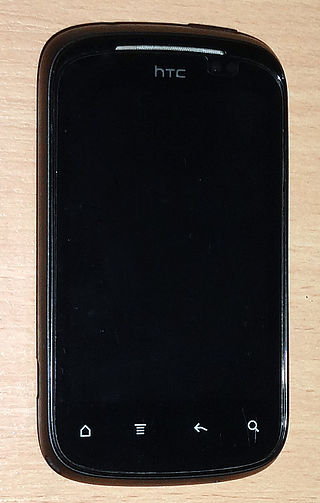Adreno is a series of graphics processing unit (GPU) semiconductor intellectual property cores developed by Qualcomm and used in many of their SoCs.

Snapdragon is a suite of system on a chip (SoC) semiconductor products for mobile devices designed and marketed by Qualcomm Technologies Inc. The Snapdragon's central processing unit (CPU) uses the ARM architecture. As such, Qualcomm often refers to the Snapdragon as a "mobile platform". Snapdragon semiconductors are embedded in devices of various systems, including vehicles, Android, Windows Phone and netbooks. In addition to the processors, the Snapdragon line includes modems, Wi-Fi chips and mobile charging products.

A smartbook was a class of mobile device that combined certain features of both a smartphone and netbook computer, produced between 2009 and 2010. Smartbooks were advertised with features such as always on, all-day battery life, 3G, or Wi-Fi connectivity and GPS in a laptop or tablet-style body with a screen size of 5 to 10 inches and a physical or soft touchscreen keyboard.
Google Nexus is a discontinued line of consumer electronic devices that run the Android operating system. Google managed the design, development, marketing, and support of these devices, but some development and all manufacturing were carried out by partnering with original equipment manufacturers (OEMs). Alongside the main smartphone products, the line also included tablet computers and streaming media players; the Nexus started out in January 2010 and reached its end in October 2016, replaced by Google Pixel.
The HTC Evo Shift 4G is a smartphone developed by HTC Corporation and marketed as the concurrent/sequel to Sprint's flagship Android smartphone, running on its 4G WiMAX network. The smartphone launched on January 9, 2011.

The HP Pre 3, styled as Pre3, is a touchscreen slider smartphone manufactured by Hewlett-Packard. The device uses webOS, is powered by a Qualcomm Snapdragon processor, and has a 3.6-inch screen. It is conceptually the successor to the Palm Pre 2 and earlier Pre and Pre Plus models.

The Samsung Galaxy Mini (GT-S5570[B/L/i]) is a smartphone manufactured by Samsung that runs the Android operating system. It was announced and released by Samsung in early 2011. In some markets it is known as Samsung Galaxy Next/Pop/NG, while it is sold in the United States as the Samsung Dart exclusively for T-Mobile. It is currently available in four different colors; steel grey, white, lime and orange. With this release, the face buttons were changed to capacitive touch, matching the rest of the Galaxy lineup.

The Samsung Galaxy Fit S5670 is a smartphone manufactured by Samsung that runs the open source Android operating system.

Xiaomi Mi1,, is a high-end, Android smartphone produced by Xiaomi. The device uses a Qualcomm Snapdragon S3 as its CPU and an Adreno 220 as its GPU. The device is initially sold at a price of ¥1999. When it was released, the device received more than 300,000 pre-orders in the first 34 hours.

The HTC Explorer, code-named Pico, is a smartphone developed by the HTC Corporation that was released in October 2011. Because of the low end processor, the HTC Watch movie rental service and the 3D scrolling effects on the home screens were not available. The handset was available in four varieties of color options. Visually similar to the HTC Wildfire S, it comes with a 3.2-inch screen, a 600 MHz ARMv7 Qualcomm Snapdragon processor and runs Android version 2.3 (Gingerbread), bundled with the proprietary HTC Sense 3.5 user interface.

Samsung Galaxy W (i8150), also known as Samsung Wonder, is an Android smartphone that is a smaller-sized variant of Samsung Galaxy S II.

Samsung Galaxy Ace 2 (GT-I8160) is a smartphone manufactured by Samsung that runs the Android operating system. Announced and released by Samsung in February 2012, the Galaxy Ace 2 is the successor to the Galaxy Ace Plus.
The Samsung Galaxy S Relay 4G is an Android touchscreen slider smartphone designed and manufactured by Samsung for T-Mobile USA. It resembles the Samsung Epic 4G in appearance and shares the Epic 4G's screen and camera specifications, but the CPU and other internal hardware is more similar to the Samsung Galaxy S III.

The Motorola RAZR i (XT890) is a smartphone designed by Motorola Mobility. It was officially announced on 18 September 2012 in London, UK.

The Xiaomi Redmi 1S, code-named armani HM 1S, is a smartphone released in May 2014, developed by the Chinese company Xiaomi Inc. It is a part of the Redmi series of smartphones, and succeeded the Redmi 1. Visually similar to its predecessor, it comes with a 4.7-inch screen, a quad-core 1.6 GHz Cortex-A7 processor and runs Android version 4.3 (Jellybean), bundled with the proprietary MIUI v5 user interface, which can be upgraded to MIUI v9 based on Android 4.4.4 KTU84P.

The Samsung Galaxy J5 is an Android smartphone produced by Samsung Electronics. It was unveiled and released in June 2015. It has Qualcomm Snapdragon 410 SoC that is backed by 1.5 GB RAM and that has a 64 bit processor, 32bit mode OS.

The Xiaomi Redmi Note 3 is a smartphone developed by Xiaomi Inc. as part of Xiaomi's low-end Redmi smartphone line. It has three variants:

The Xiaomi Redmi Note 4 is the fourth smartphone under the Redmi Note series developed by Xiaomi Inc. It is a part of Xiaomi's budget Redmi smartphone lineup. It has two variants : The older version sold as Redmi Note 4 is powered by a Deca-core Mediatek MT6797 Helio X20 SOC. The upgraded version, sold both as Redmi Note 4X and Redmi Note 4 is powered by an Octa-core MSM8953 Qualcomm Snapdragon 625 SoC. The Redmi Note 4 was succeeded by Redmi Note 5.

The Samsung Galaxy A52 is a mid-range Android-based smartphone developed and manufactured by Samsung Electronics as a part of its Galaxy A series. The phone was announced on 17 March 2021 at Samsung's virtual Awesome Unpacked event alongside the Galaxy A72.
















